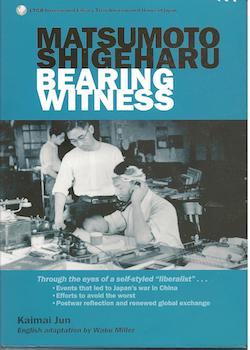Matsumoto Shigeharu: Bearing Witness

By Kaimai Jun
English adaption by Waku Miller
LTCB International Library Trust and International House of Japan
2012, 219 pages
ISBN 978-4=924971-33-2
Review by Hugh Cortazzi
Shigeharu Matsumoto [松本重治] was a well-known internationalist with many friends outside Japan including politicians, journalists and diplomats. He is particularly remembered as the founder and developer of the International House of Japan in Roppongi in Tokyo which with its seminar rooms, library and accommodation for scholars has contributed so much to exchanges between Japanese and foreign scholars. But he was much more than a major participant in international exchanges. He was an influential journalist who was able to view from his post as correspondent of Rengo [新聞聯合社] and later of Domei [同盟通信社] the course of Japan’s war in China with its tragic consequences for Japan as well as for China. He was an active participant in the internationalization of Japan in the latter part of the twentieth century. As Jun Kaimai declares in his introduction, Japan as it grapples with globalization and ‘diversity’ has much to learn from Shigeharu Matsumoto.
The translator in his preface explains that Matsumoto referred to himself as the ‘old liberalist’ whose worldview was one of “a broad-minded receptivity tinged by a sometimes touching, sometimes troubling naïveté. Matsumoto came to prominence in 1936 as the journalist who broke the news of Chiang Kai-shek’s detention in the Xi’an incident. And he subsequently played a central role in initiatives aimed at ending the conflict that had broken out between China and Japan.”
Shigeharu Matsumoto (1899-1989) was brought up in Osaka. He studied law and English at Tokyo University before going in 1923 to the USA to study economics and history at Yale. He went on to Europe in 1925, where he interpreted for Japanese delegates at an ILO conference in 1926. His ambition of becoming a professional journalist was fulfilled when he was appointed as the head of the Shanghai bureau of the Rengo (later Domei) news agency, In 1936 his reporting of the Xi’an incident was a news scoop which marked him out as a well-connected and influential journalist and brought him into contact with Japanese leaders including Fumimaro Konoe [近衛 文麿] whom he warned “Japan mustn’t humiliate the Chinese by taking Nanjing.” Unfortunately his warning fell on deaf ears and his efforts to find an accommodation between Japan and China failed.
Matsumoto was in a position to know what Japanese troops did in Nanjing when they occupied the city. He was aware that “Japanese soldiers had undeniably run amok, raping, looting, and murdering with abandon. He bore a profound shame about what his countrymen had perpetrated in Nanjing(page 94).”
Matsumoto contracted typhoid fever and his health deteriorated. He retired temporarily to Karuizawa, but when Yukichi Iwanaga [岩永 裕吉], President of Domei, died in 1939, Matumoto agreed to become editor in chief of Domei, a post which he held until 1943 when illness forced him to relinquish this post. As he had served for some years in Japan’s official news agency it was perhaps inevitable that he should be purged by the occupation authorities. But he was fairly soon rehabilitated and began to play an influential role in developing overseas exchanges especially with the US. His friendships with leading Americans did not inhibit him as a ‘liberalist’ from criticizing mistaken American policies e.g. in Vietnam.
Shigeharu Matsumoto deserves to be remembered as a liberal minded internationalist. He would have been depressed by the illiberal inward-looking tendencies today of some Japanese, old, middle-aged and young.
Note
The subtitle of this book is: ‘Through the eyes of a self-styled “liberalist”…Events that led to Japan’s war in China, Efforts to avoid the worst, Postwar reflection and renewed global exchange.’

